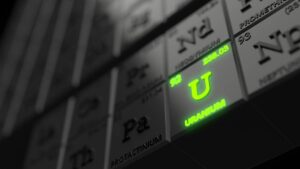Uranium inventories are scarily low – here’s what that means for energy security, prices and new projects

Pic: PM Images / Stone / Stone via Getty Images
- US nuclear utilities have only 16 months of inventory, and the EU has only two years’ worth
- COVID and Russia/Ukraine war have impacted supply chain security and pushed up prices
- Geopolitically stable locations will have the advantage as industry rushes to meet demand
The International Atomic Energy Agency’s (IAEA) Uranium Production Specialist Dr Adrienne Hanly has flagged that uranium inventories are precariously low.
At the recent World Nuclear Fuel Cycle conference in London, Dr Hanly said uranium fuel inventory levels for US nuclear utilities are at just 16 months of requirements – below recommended 2+ years minimum.
And that US utilities may have limited capability to independently manage a protracted supply disruption.
Compounding this, EU stocks on aggregate equate to two years’ supply, but many individual utilities fall far short of this ESA-prescribed benchmark.
Here are the most important 3 slides from Ms. Hanly’s talk. Show #uranium inventories in the U.S. and EU & explains why analyzing inventories based on regional averages is misleading (large dispersion btwn utilities). Formal report from IAEA expected in mid 2023. #nuclear pic.twitter.com/XIdwG4vNon
— Art Hyde (@JekyllCapital) April 29, 2022
Industry has relied on inventory – not new mines
The comments caught the attention of Boss Energy (ASX:BOE) MD and CEO Duncan Craib, who said while the company knew inventory levels were low, they hadn’t appreciated levels were that low.
“Secondary uranium supplies are inventory and they’re historically filled the gap in uranium demand that was not filled by primary uranium production,” he said.
“And over the past 10 years, because the commodity has been in the doldrums or the price has been so low, the incentive price hasn’t encouraged any new mines to be developed, or any funding into exploration on a large scale to find new mineral resources of uranium.
“So essentially, the industry has really relied on existing inventory levels, and they’ve been drawn down and drawn down.
“You’ve got no new mines being built, you’ve got no new resource discoveries, so that uranium price now has to rise to incentivise new mines to come online.”
Spot price hit the magic US$60/lb mark
Craib also said the impact of declining inventory levels has been compounded by COVID and Russia’s invasion of Ukraine – which pushed the spot price to an 11-year high of US$60/pound recently.
“The first thing we had was COVID two years ago, that started affecting the industry because primary producers Kazakhstan and Canada had employees being unable to work, which caused major rolling shutdowns,” he said.
“Then at the start of this year, you had civil unrest in Kazakhstan, which while it only went for two or three weeks, really highlighted the concerns on the political stability, supply chain security, and that potential impact on uranium production.
“And then in late February, Russia invaded Ukraine, and with that has come economic sanctions; that’s really impacted global energy markets – not only uranium, but oil and natural gas.”
Russia accounts for about 35% of global uranium enrichment and about 16-17% of that is imported into the US.
Plus, Kazakhstan supplies around 40% of the world’s uranium which is shipped out of the Russian ports, so the threat of sanctions on Russia could directly impact supply.
“The uncertainty on the future security of supply has really pressured the uranium price to move higher,” Craib said.
“That’s why we’re seeing the spot price around US$54/pound today, and it was as high as US$60 a few weeks ago.”
And uranium players around the world are swinging back into action.
World #Nuclear Association is now reporting 440 operable reactors (393 GW) + 55 more under construction (61GW)⚛️ ️ with 26 expected to come online this year & next.⚡️ 96 more in advanced planning/ordered + number proposed just lifted by 10 to 335 ↗️ ️ #Uranium #NetZero #ESG pic.twitter.com/O8okNaLf6T
— John Quakes (@quakes99) May 10, 2022
Geopolitically stable projects have an advantage
Craib says this geopolitically instability and worries around supply chain security are advantageous for projects like its Honeymoon mine in South Australia.
“If we were in a tender process and all factors were considered equal in terms of the ability to supply, the acceptance of the price and then they looked at where we’re geographically situated in Australia, they’d move us to the front of the queue,” he said.
“New mines in stable and uranium-favourable environments are going to be prioritised and that’s where Australia – and in particular South Australia which has got the only producing uranium mine – has got a seat at the table.
“It’s an industry that’s set to really grow and Boss Energy is really well positioned to take advantage of that rising uranium market with compelling fundamentals.”
The company released the FEED study on the $113 million restart of the mine in March, with a final investment decision “imminent”.
The FEED showed an internal rate of return of 47% at a US$60/lb U308 price, with nameplate production of 2.45Mlb U308 per annum at an AISC of US$25.60 over Life of Mine.
“We’re looking to be in production within a 12-18 month period,” Craib said.
And he flagged that beyond which jurisdiction they’re in, investors should look at which players in the industry have proven uranium experience on their management teams – with experience mining, exporting, and selling the product.
Related Topics

UNLOCK INSIGHTS
Discover the untold stories of emerging ASX stocks.
Daily news and expert analysis, it's free to subscribe.
By proceeding, you confirm you understand that we handle personal information in accordance with our Privacy Policy.








